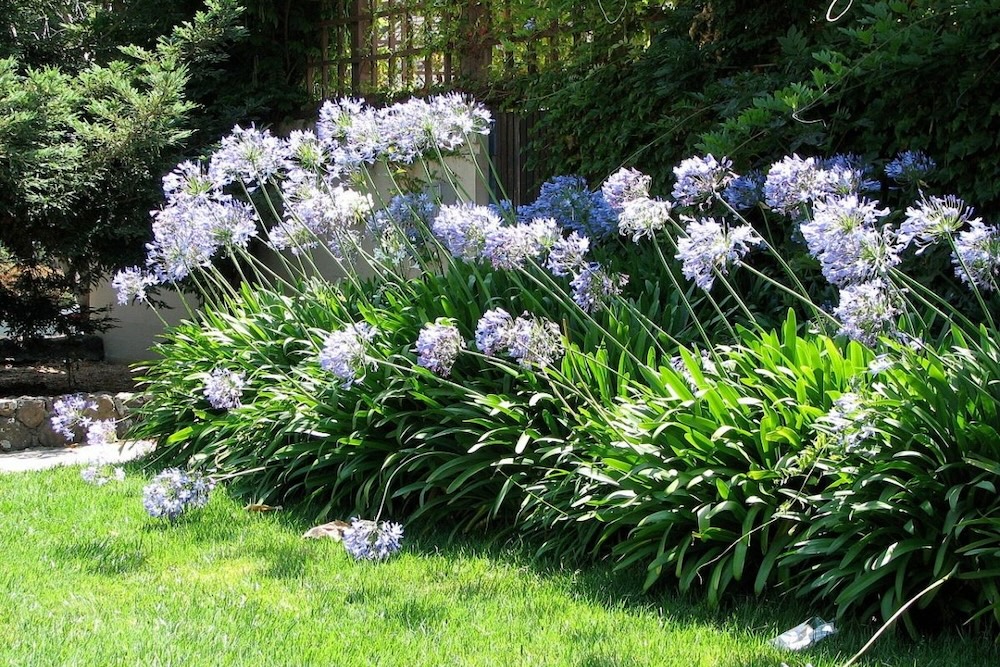Growing Agapanthus: A Full Overview to Beautiful Blooms
Growing Agapanthus: A Full Overview to Beautiful Blooms
Blog Article
Releasing the Secret to Successful Agapanthus Cultivation: Advice for a Flourishing Yard
In the realm of gardening, cultivating agapanthus successfully needs a critical approach that includes various elements of plant care. By understanding the subtleties of agapanthus growing, one can develop a setting where these plants grow and grow perfectly.
Planting Agapanthus: Finest Practices
When planting Agapanthus, correct dirt preparation is essential for making sure effective development and development of these attractive flowers. Agapanthus, commonly understood as Lily of the Nile or African lily, grows in well-draining soil with a somewhat acidic to neutral pH level - Agapanthus. Prior to planting, it is critical to amend hefty clay dirts with raw material such as garden compost or peat moss to boost drain and supply necessary nutrients for the plants
To plant Agapanthus, pick a place that obtains full sunshine to partial color, as this will promote healthy development and plentiful blooming. Dig a hole twice the diameter of the plant's root sphere and position the Agapanthus at the same deepness it was formerly expanding. Delicately backfill the opening with soil, weighing down securely to get rid of any air pockets around the roots.
Water the recently grown Agapanthus extensively and remain to keep the dirt evenly damp, specifically during the plant's energetic expanding season. Agapanthus. Using a balanced fertilizer once a month can even more support the plant's development and flowering. By following these best methods for growing Agapanthus, you can develop a magnificent display of these captivating blossoms in your garden
Perfect Dirt Issues for Agapanthus
For optimal growth and flowering success of Agapanthus plants, making sure the soil conditions are perfect is vital. Agapanthus chooses dirt that is abundant in nutrients, so incorporating a well balanced fertilizer throughout the expanding season can promote healthy development and dynamic blossoms.

Watering and Fertilizing Tips
To make sure healthy and balanced development and vivid blossoms, correct watering and feeding methods are vital for effective Agapanthus cultivation. Agapanthus plants benefit from regular watering, especially throughout the growing period.
When it pertains to fertilizing Agapanthus, a balanced fertilizer with equivalent parts nitrogen, phosphorus, and potassium can be applied in the spring to promote healthy and balanced development and flowering. Slow-release plant foods are excellent for giving nutrients progressively over a prolonged duration. Prevent over-fertilizing, as this can result in too much foliage growth at the expenditure of blossoms.
Furthermore, including raw material like garden compost into the soil can enhance nutrient degrees and enhance soil framework, helping in the total wellness of the Agapanthus plants. By following these watering and fertilizing tips, garden enthusiasts can guarantee their Agapanthus plants thrive and create spectacular display screens of blossoms.
Trimming and Deadheading Strategies
Proper pruning and deadheading strategies play a vital function in keeping the wellness and looks of Agapanthus plants, complementing the crucial methods of watering and feeding for successful growing. Trimming Agapanthus involves eliminating spent blossom heads, yellowing or dead fallen leaves, and overall shaping of the plant to promote far better growth. Deadheading, the process of getting rid of faded flowers, not only boosts the plant's appearance however additionally encourages further flowering.
When deadheading Agapanthus, it is suggested to snip off the blossom stem at the base making use of sharp, tidy shears. This procedure redirects the plant's power from seed manufacturing back right into read the article root and vegetation growth, advertising a healthier and extra robust plant. Routine deadheading can prolong the growing period of Agapanthus and prevent self-seeding, which can result in congestion.
In terms of pruning, Agapanthus typically benefits from a light trim after blooming to clean up the plant and encourage fresh growth. Cutting down the invested blossom stems and eliminating any type of dead or damaged vegetation helps maintain the plant's vitality and overall appearance. Nonetheless, it is important to prevent cutting into the crown of the plant, as this can compromise its explanation health.

Protecting Agapanthus From Vermins and Diseases
Executing efficient parasite and condition monitoring methods is crucial to securing the wellness and vitality of Agapanthus plants in growing. One common pest that influences Agapanthus is the Agapanthus borer, a caterpillar that passages into the plant, creating damage to the leaves and flowers.
In addition to pests, Agapanthus are vulnerable to illness such as origin rot and fungal next fallen leave spots. These problems can often be protected against by making certain appropriate water drainage and staying clear of overwatering. If indications of illness appear, affected components of the plant ought to be quickly removed to prevent additional spread. Fungicides may likewise be made use of as a therapy procedure, complying with the producer's guidelines very carefully. By remaining attentive and attending to pest and disease problems quickly, gardeners can assist their Agapanthus thrive and thrive.

Verdict
In conclusion, effective farming of agapanthus calls for proper planting techniques, excellent dirt conditions, adequate watering and feeding, routine pruning and deadheading, and protection from pests and conditions. By following these methods and ideas, garden enthusiasts can make sure a prospering garden loaded with stunning agapanthus blossoms. Agapanthus. Remember to keep constant treatment and attention to detail to advertise the wellness and durability of these sensational plants
When growing Agapanthus, correct soil preparation is crucial for guaranteeing effective development and growth of these gorgeous flowers.Water the newly planted Agapanthus extensively and proceed to maintain the soil evenly damp, particularly throughout the plant's energetic growing period.For optimum growth and growing success of Agapanthus plants, making certain the soil conditions are perfect is vital. When growing or transplanting Agapanthus, make certain the soil is well-prepared to offer the required structure for the plants to establish themselves effectively. One typical parasite that influences Agapanthus is the Agapanthus borer, a caterpillar that passages right into the plant, causing damage to the leaves and flowers.
Report this page